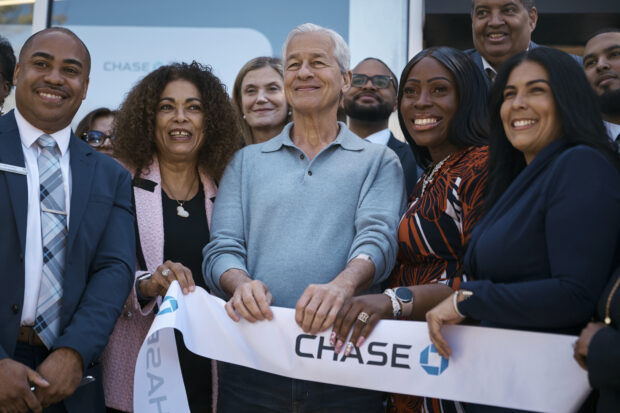
Jamie Dimon, CEO and chairman of JPMorgan Chase, center, attends the ribbon-cutting ceremony during the community branch opening in the Bronx borough of New York, on Friday, April 26, 2024. (AP Photo/Andres Kudacki)
NEW YORK — JPMorgan Chase CEO Jamie Dimon says he’s hopeful the Federal Reserve can bring down inflation without causing a recession but wouldn’t rule out more troubling possibilities, such as stagflation.
In an interview with The Associated Press at a Chase branch opening in The Bronx, Dimon said he remained “cautious” about the U.S. economy and said inflation might be stickier for longer and that “stagflation is on the list of possible things” that could happen to the U.S. economy.
“You should be worried about (the possibility of stagflation),” Dimon said.
Dimon did emphasize that he’s still “hopeful” for the U.S. economy to experience a soft landing, where growth slows but the economy avoids a recession even if inflation remains a little high, but he’s not certain that is the most likely outcome.
“I’m just a little more dubious than others that a (soft landing) is a given,” he said.
READ: JPMorgan Chase CEO warns inflation could stay high
The Fed rapidly raised interest rates in 2022 and 2023 after inflation reached its highest level in four decades.
Fed officials have indicated they expect to begin lowering rates at some point, but the timeline has been pushed back as inflation remains well above the central bank’s target rate of 2 percent.
Stagflation fears
Dimon spoke to the AP on a range of issues, including the economy, the independence of the Federal Reserve, the need for banks to open branches, and the pressing geopolitical issues of the day.
Inflation has been stubbornly elevated so far this year, and a report Thursday showing growth slowed in the first three months of this year fanned fears of “stagflation,” which occurs when the economy is weak, or in recession, yet prices keep moving higher. It’s a particularly miserable combination of economic circumstances, with high unemployment occurring along with rising costs. Typically, a sluggish economy brings down inflation.
READ: Stagflation: What is it and why is it a cause for concern?
Stagflation last occurred in the 1970s, when conditions were far worse than today. In 1975, for example, inflation topped 10 percent while the unemployment rate peaked at 9 percent.
Inflation is now 3.5 percent and unemployment is 3.8 percent, near a half-century low. If stagflation did occur, Dimon said he believes it would not be as bad as it was in the 1970s.
Fears of stagflation eased Friday after a government report showed consumer spending stayed strong in March, suggesting the economy will keep expanding at a solid pace in the coming months.
READ: Retail sales surged 0.7% in March as Americans boosted spending
Dimon said he was “thrilled” that Congress was able to pass the bipartisan national security bill that provided military aid to Ukraine, Taiwan, and Israel.
‘American leadership’
In previous comments, Dimon has said it was important for there to be “American leadership” on the world stage, or else the U.S. would likely cede that position to China in the next century. Dimon had pushed hard for the U.S. to come up with the billions of dollars needed to aid Ukraine.
“I think it’s a really good sign they want to get that done,” Dimon said, referring to House Speaker Mike Johnson, as well as Senate leaders on both sides of the political aisle.
Dimon also emphasized the need for the Federal Reserve to remain independent, following a report by The Wall Street Journal this week that said advisors for former President Trump were considering ways to curb the independence of the Fed should again be elected.
The steps could include making the Fed’s chairman removable by the president or requiring the president to be consulted on any changes to interest rates.
“I don’t know what these people are thinking, or how they think they are going to go about this,” Dimon said, saying that any changes would likely require legislation.
Focus on low-income communities
Chase was opening its 17th “community center” branch on Friday. These are larger branches that are designed for low-to-moderate-income areas. They are designed with multipurpose areas that do workshops and financial literacy work for communities in need.
Dimon has tried to highlight JPMorgan’s work with low-income communities and minority borrowers in recent years. He spent six pages on his most recent annual shareholder letter explaining how important for JPMorgan to be involved in diversity, equity, and inclusion initiatives, pushing back on mostly right-wing politicians and business executives who say the work is unnecessary.
“These things are good business,” Dimon said. They lift neighborhoods to help our country. And we’re unabashed about it. I don’t understand why people say they shouldn’t be trying to lift up your country.”
Glennys Arias, 43, lives in the Bronx and works as an Uber driver. She’s been banking with Chase for six months and said she typically comes to use the ATM, for check cashing, and to check on her credit.
She said the branch met her needs and she hadn’t heard about the expansion or upcoming classes or events. “I didn’t know about any of that, but I’d come for that,” she said, of the programming.
In off-the-cuff remarks, Dimon noted the steady stream of customers.
“I love the fact that so many people are walking in here. So many people are nervous about how they’ll be treated when they walk into a bank branch.”